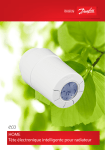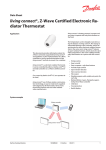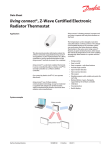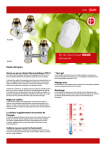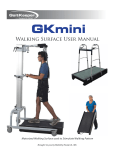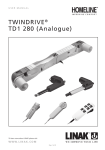Download Danfoss Living Eco User guide
Transcript
Installation and User Guide living eco® Electronic Radiator Thermostat Danfoss Heating Solutions VIIDB102 01/2013 1 Installation and User Guide living eco® Electronic Radiator Thermostat Congratulations on the purchase of your living eco® radiator thermostat living eco® is an electronic radiator thermostat with programmes to automatically lower the room temperature for selected periods. This allows you to save heating expenses and benefits the environment by using less energy. For further information, please see www.danfoss.com/living 2 01/2013 VIIDB102 Danfoss Heating Solutions Installation and User Guide living eco® Electronic Radiator Thermostat Table of Contents 1.Installation 1.1In the package . . . . . . . . . . . . . . . . . . . . . . . . . . . . . . . . . . . . . . . . . . . . . . . . . . . . . . . . . . . . . . . . . . . . . . . . . . . . . . . . 4 1.2 Inserting the batteries . . . . . . . . . . . . . . . . . . . . . . . . . . . . . . . . . . . . . . . . . . . . . . . . . . . . . . . . . . . . . . . . . . . . . . . . . 4 1.3Setting the time and date when you start using living eco® . . . . . . . . . . . . . . . . . . . . . . . . . . . . . . . . . . . . . . 4 1.4Installing living eco® . . . . . . . . . . . . . . . . . . . . . . . . . . . . . . . . . . . . . . . . . . . . . . . . . . . . . . . . . . . . . . . . . . . . . . . . . . . 4 2. Getting started with living eco® 2.1 Thermostat display . . . . . . . . . . . . . . . . . . . . . . . . . . . . . . . . . . . . . . . . . . . . . . . . . . . . . . . . . . . . . . . . . . . . . . . . . . . . 5 2.2 Thermostat buttons . . . . . . . . . . . . . . . . . . . . . . . . . . . . . . . . . . . . . . . . . . . . . . . . . . . . . . . . . . . . . . . . . . . . . . . . . . . 5 2.3 Display symbols . . . . . . . . . . . . . . . . . . . . . . . . . . . . . . . . . . . . . . . . . . . . . . . . . . . . . . . . . . . . . . . . . . . . . . . . . . . . . . . 5 3. More features of living eco® 3.1 Adjusting the temperature . . . . . . . . . . . . . . . . . . . . . . . . . . . . . . . . . . . . . . . . . . . . . . . . . . . . . . . . . . . . . . . . . . . . 7 3.2 Frost protection, 6°C . . . . . . . . . . . . . . . . . . . . . . . . . . . . . . . . . . . . . . . . . . . . . . . . . . . . . . . . . . . . . . . . . . . . . . . . . . . 7 3.3Programmes . . . . . . . . . . . . . . . . . . . . . . . . . . . . . . . . . . . . . . . . . . . . . . . . . . . . . . . . . . . . . . . . . . . . . . . . . . . . . . . . . . 7 3.4 Selecting the programme . . . . . . . . . . . . . . . . . . . . . . . . . . . . . . . . . . . . . . . . . . . . . . . . . . . . . . . . . . . . . . . . . . . . . 8 3.5 Adjusting the setback period in programme P1 or P2 . . . . . . . . . . . . . . . . . . . . . . . . . . . . . . . . . . . . . . . . . . . 8 3.6 Deleting a setback period . . . . . . . . . . . . . . . . . . . . . . . . . . . . . . . . . . . . . . . . . . . . . . . . . . . . . . . . . . . . . . . . . . . . . 9 3.7 Creating a new setback period in P1 or P2 . . . . . . . . . . . . . . . . . . . . . . . . . . . . . . . . . . . . . . . . . . . . . . . . . . . . . . 9 3.8 Travel programme . . . . . . . . . . . . . . . . . . . . . . . . . . . . . . . . . . . . . . . . . . . . . . . . . . . . . . . . . . . . . . . . . . . . . . . . . . . . 10 3.9 Function menu . . . . . . . . . . . . . . . . . . . . . . . . . . . . . . . . . . . . . . . . . . . . . . . . . . . . . . . . . . . . . . . . . . . . . . . . . . . . . . 11 3.10 Installation mode . . . . . . . . . . . . . . . . . . . . . . . . . . . . . . . . . . . . . . . . . . . . . . . . . . . . . . . . . . . . . . . . . . . . . . . . . . . . 11 3.11 Temperature limit . . . . . . . . . . . . . . . . . . . . . . . . . . . . . . . . . . . . . . . . . . . . . . . . . . . . . . . . . . . . . . . . . . . . . . . . . . . . 11 3.12 Setting the time . . . . . . . . . . . . . . . . . . . . . . . . . . . . . . . . . . . . . . . . . . . . . . . . . . . . . . . . . . . . . . . . . . . . . . . . . . . . . . 11 3.13 Child lock . . . . . . . . . . . . . . . . . . . . . . . . . . . . . . . . . . . . . . . . . . . . . . . . . . . . . . . . . . . . . . . . . . . . . . . . . . . . . . . . . . . . 11 3.14 Replacing the batteries . . . . . . . . . . . . . . . . . . . . . . . . . . . . . . . . . . . . . . . . . . . . . . . . . . . . . . . . . . . . . . . . . . . . . . . 12 3.15 Open window function . . . . . . . . . . . . . . . . . . . . . . . . . . . . . . . . . . . . . . . . . . . . . . . . . . . . . . . . . . . . . . . . . . . . . . . 12 3.16 Reset to factory settings . . . . . . . . . . . . . . . . . . . . . . . . . . . . . . . . . . . . . . . . . . . . . . . . . . . . . . . . . . . . . . . . . . . . . . 12 4. Technical settings 4.1 Advanced menu . . . . . . . . . . . . . . . . . . . . . . . . . . . . . . . . . . . . . . . . . . . . . . . . . . . . . . . . . . . . . . . . . . . . . . . . . . . . . .13 4.2 Deactivating automatic daylight saving time . . . . . . . . . . . . . . . . . . . . . . . . . . . . . . . . . . . . . . . . . . . . . . . . . . 13 4.3 Adjusting to radiator/room . . . . . . . . . . . . . . . . . . . . . . . . . . . . . . . . . . . . . . . . . . . . . . . . . . . . . . . . . . . . . . . . . . . 13 4.4 Deactivating intelligent control . . . . . . . . . . . . . . . . . . . . . . . . . . . . . . . . . . . . . . . . . . . . . . . . . . . . . . . . . . . . . . . 13 4.5 Technical specifications . . . . . . . . . . . . . . . . . . . . . . . . . . . . . . . . . . . . . . . . . . . . . . . . . . . . . . . . . . . . . . . . . . . . . . . 14 5. Safety precautions . . . . . . . . . . . . . . . . . . . . . . . . . . . . . . . . . . . . . . . . . . . . . . . . . . . . . . . . . . . . . . . . . . . . . . . . . . . . . . . . . . 15 6. Removing living eco® . . . . . . . . . . . . . . . . . . . . . . . . . . . . . . . . . . . . . . . . . . . . . . . . . . . . . . . . . . . . . . . . . . . . . . . . . . . . . . . 15 7. Disposal . . . . . . . . . . . . . . . . . . . . . . . . . . . . . . . . . . . . . . . . . . . . . . . . . . . . . . . . . . . . . . . . . . . . . . . . . . . . . . . . . . . . . . . . . . . . 15 Danfoss Heating Solutions VIIDB102 01/2013 3 Installation and User Guide living eco® Electronic Radiator Thermostat 1. Installation 1.1 In the package living eco® is supplied with adapters for Danfoss RA valves and valves with M30 x 1.5 (K) connections, two alkaline AA batteries and a 2 mm Allen key. 1.2 Inserting the batteries Remove the battery cover and insert the two batteries. Make sure the batteries are correctly oriented. 1.3 Setting the time and date when you start using living eco® Once the batteries are installed The time will flash on the display - 23:59. Set the time Set hours using Set min. using Set date Set date using and press . Format: day/month/year (DD/MM/YYYY) Confirm setting When and press . and press . flashes, press to confirm. 1.4 Installing living eco® M must be flashing on the display prior to installing. If not, see Installation mode on page 11. 1. Start by mounting the adapter. RA K 2. Tighten RA adapter using the 2 mm Allen key. Hand-tighten K adapter (max. 5 Nm). 3. Screw the thermostat onto the adapter and tighten by hand (max. 5 Nm). 4. Press for approx. 3 seconds to enter the function menu. 5. A small M flashes, press 4 01/2013 to fix the thermostat. VIIDB102 Danfoss Heating Solutions Installation and User Guide living eco® Electronic Radiator Thermostat 2. Getting started with living eco® 2.1 Thermostat display The black dashed circle on the display shows a 24-hour dial. The black segments represent periods of comfort temperature, 21°C (default setting), and the ‘empty’ segments represent setback periods, where the temperature is 17°C (default setting). The display also shows the set temperature and current program. 24 P1 24-hour dial Half hour segments Shows the program the thermostat is running (e.g. P1). Setback period 22:30 - 06:00 hrs, 17°C Fr 18 6 Weekday Programmed temperature Battery symbol 12 Flashes at the current time 2.2 Thermostat buttons The thermostat has two arrow buttons which allow you to navigate the display, menus and set the temperature. Use to select and confirm. 2.3 Display symbols Symbols flash when they can be activated. Programme Menu P0 Programme with no automatic temperature reduction – maintains a constant temperature all day and night. You select the temperature. P1 Saving programme which lowers the temperature to 17°C at night (22:30 - 06:00 hrs). Saving programme is configurable. P2 Extended saving programme which lowers the temperature to 17°C at night (22:30 - 06:00 hrs), and during the day on weekdays (08:00 - 16:00 hrs). Saving programme is configurable. Travel programme which lowers the temperature when you are away. You select the period and the temperature. Danfoss Heating Solutions VIIDB102 01/2013 5 Installation and User Guide living eco® Electronic Radiator Thermostat Function Menu M Installation mode (see page 11). Child lock. MAX MIN Set the max and min temperature range. Set time and date. Other Symbols Back. Confirm selection. Battery symbol (indicates low battery). Period setting for the travel programme. 6 01/2013 VIIDB102 Danfoss Heating Solutions Installation and User Guide living eco® Electronic Radiator Thermostat 3. More features of living eco® 3.1 Adjusting the temperature Set the desired temperature by pressing Default setting is 21°C. . This also allows the temperature to be changed temporarily during a setback period, without having to change the program or period. 24 P1 Fr 18 6 12 If the comfort temperature is changed, e.g. from 21°C to 22°C, living eco® will remember this change, and the comfort temperature will remain 22°C after the next setback period. 3.2 Frost protection, 6⁰C This symbol is displayed if you set the thermostat to its lowest setting. This means that the thermostat will maintain a constant temperature of 6 °C in the room, ensuring frost protection. 24 6 18 12 3.3 Programmes When you start using the thermostat it is set to use program P1. You can select the programme which best matches your family’s requirements. P0: Constant temperature of 21°C all day and night. Danfoss Heating Solutions P1: One setback period at 17°C every night from 22:30 - 06:00 hrs. VIIDB102 P2: Two setback periods at 17°C every night from 22:30 - 06:00 hrs and all weekdays from 08:00 - 16:00 hrs. 01/2013 7 Installation and User Guide living eco® Electronic Radiator Thermostat 3.4 Selecting the programme Select programme menu If the display is off, press . Then press briefly to open the programme menu. Selecting the programme (P0, P1 or P2) Switch between programmes using Select using . Confirm setting When flashes, press . to confirm. 3.5 Adjusting the setback period in programme P1 or P2 The thermostat default setting is one setback period for P1 and two setback periods for P2. You can adjust the setback periods so they match your family’s requirements. When living eco® is set to change from 17°C to 21°C, e.g. at 06.00 hrs, the thermostat will learn when to start heating in order for the temperature to reach 21°C at 06.00 hrs. Select programme menu If the display is off, press programme menu. Select programme (P1 or P2) Press press Weekdays for setback period to activate. Then press briefly to open the to highlight the desired programme. When the programme flashes, to select it. Mo Tu We Th Fr Sa Su Monday Tuesday Wednesday Thursday Friday Saturday Sunday You can select to adjust the setback period for the weekend, all weekdays, or a single day. Use to select the desired period. When the desired period flashes, press to select it. Setback period interval You are using to move around the 24-hour dial. For example when moving from one setback period to the next setback period. Use to move between the start and stop times. The time flashes slowly when it can be selected. Select time using . Once the time has been selected it flashes faster to indicate it can now be adjusted. Set the start and stop time using . Once the time is chosen, confirm using . Change temp. if required The temperature now flashes. Set the temperature using . Once the desired temperature is chosen, confirm using . now flashes. (If you do not wish to change the setback period, press so that the symbol flashes, and then select using . You will be returned to the weekdays for setback period selection menu). Press to approve the entire setback period. Confirm setback period 8 01/2013 flashes. Press to run the selected programme. VIIDB102 Danfoss Heating Solutions Installation and User Guide living eco® Electronic Radiator Thermostat 3.6 Deleting a setback period You can delete a setback period by minimising it to half an hour. All segments on the timer dial will then become black. Example In this example the setback period is Monday, 08.30-16.00 hrs. To cancel the setback period, set the start time to 15.30 hrs. Select programme menu If the display is off, press programme menu. Select programme (P1 or P2) Press press Select setback period Cycle through the weekdays using . When the day(s) you wish to change flashes, press . Cycle through the 24-hour dial using . When the start of the setback period you wish to delete flashes slowly, press to select it. Clear setback period interval Use to set the start time so the setback period is half an hour. Once you have changed the start time, press . Confirm deletion to activate. Then briefly press to open the to highlight the desired programme. When the programme flashes, to select it. now flashes. Press to approve. You have now deleted the setback period. 3.7 Creating a new setback period in P1 or P2 living eco® also allows you to create your own setback periods in P1 or P2. You can create up to three setback periods each day. Select programme menu If the display is off, press programme menu. Select programme (P1 or P2) Press press Weekdays for setback period to activate. Then briefly press to open the to highlight the desired programme. When the programme flashes, to select it. Mo Tu We Th Fr Sa Su Monday Tuesday Wednesday Thursday Friday Saturday Sunday You can select to adjust the setback period for the weekend, all weekdays, or a single day. Use to find the desired period. When the desired period flashes, press to select it. Setback period interval To add another setback period, use to move around the 24-hour dial to find and select the new start time. Disregard existing setback periods, just move ahead with to choose your new setback period. Confirm the start time by pressing . The stop time now flashes. Set the stop time using . Once the time is chosen, confirm using . Change temp. if required The temperature now flashes. Set the temperature using using . Danfoss Heating Solutions VIIDB102 , and confirm 01/2013 9 Installation and User Guide Confirm setback period living eco® Electronic Radiator Thermostat continues flashing. (If you do not wish to create a new setback period, press so that the symbol flashes, and then select using . You will be returned to the weekdays for setback period selection menu). Press to approve the entire setback period. 3.8 Travel programme The travel programme helps you save energy by reducing the temperature when you are away from home. Simply enter the period of time you will be away, and living eco® will ensure your normal operating programme is resumed when you return, so you arrive into a warm house. Select programme menu If the display is off, press programme menu. Select programme Select Set departure date Set departure date using Set return date Set return date using Change temp. if required Press Confirm setting When flashes, press to confirm is now displayed. When the departure date arrives, the following is displayed: temperature. by pressing to activate. Then briefly press to open the until the suitcase flashes. Select using . Confirm using . Confirm using . . . to change the temperature (default is 17°C). Confirm using . , set period and Early return Select programme menu If the display is off, press menu. to activate. Press Select programme Select programme (P0/P1/P2) using briefly to open programme . Confirm using . Changing an existing travel period Select programme menu If the display is off, press menu. Select programme Select Select Change travel period Change the period by pressing Change temp. if required Press Confirm setting Confirm using by pressing by pressing to activate. Press briefly to open programme until the suitcase flashes. Select using until the clock flashes. Select using . . Select using . . to change the temperature. Confirm using . . Cancelling set travel period 10 Select programme menu If the display is off, press menu. Select programme Select Select off Select OFF using Confirm setting Confirm using 01/2013 by pressing to activate. Press briefly to open programme until the suitcase flashes. Select using . . . VIIDB102 Danfoss Heating Solutions Installation and User Guide living eco® Electronic Radiator Thermostat 3.9 Function menu M Installation mode. Always activate installation mode when installing/removing the thermostat. The thermostat may be irreparably damaged if not in the correct position during installation. Child lock - allows the buttons to be locked so your settings cannot be changed. MAX MIN Temperature limit - allows you to change the thermostat’s temperature range, so you decide what the max and min temperature should be. This is useful, for example, in rooms with public access. Set time and date - allows the time and date to be changed after the thermostat is in use. 3.10 Installation mode Select function menu Press and hold for 3 sec. Activate installation mode Select M using . M flashes, press . Now a large M is flashing in the display. The mode is activated and living eco® can be mounted. Deactivate installation mode Press and hold for 3 sec. M flashes, press Select function menu Press and hold for 3 sec. Select max/min Select max/min using . Press . Press to approve. to deactivate. 3.11 Temperature limit . Set the max and min temperature using 3.12 Setting the time The thermostat automatically changes to/from daylight saving time. Select function menu Press and hold for 3 sec. Select clock Select using . Press using . . Set time and date using . Select and confirm 3.13 Child lock Select function menu Press and hold for 3 sec. Activate child lock Select . Press Deactivate child lock Deactivate the child lock by pressing all three buttons ously for at least 5 sec. Danfoss Heating Solutions using VIIDB102 to activate the child lock. simultane- 01/2013 11 Installation and User Guide living eco® Electronic Radiator Thermostat 3.14 Replacing the batteries Remove the battery cover and insert two alkaline AA batteries. Make sure the batteries are correctly oriented. Rechargeable batteries may not be used. Programme settings are preserved. Time and date settings are reset after 2 minutes and must then be reentered. 3.15 Open window function If the thermostat detects a dramatic drop in temperature, for example due to an open window, it reacts by shutting off the heat. The thermostat returns to its original setting after half an hour, or when the window is closed. 3.16 Reset to factory settings Remove the battery cover and take out one battery. Press and hold the battery. 12 01/2013 VIIDB102 for approx. 5 seconds, while reinserting Danfoss Heating Solutions Installation and User Guide living eco® Electronic Radiator Thermostat 4. Technical Settings 4.1 Advanced menu dS Deactivate/activate automatic daylight saving time. Pb Adjust to radiator/room Fo Deactivate/activate intelligent control (forecast) Or Information about horizontal or vertical orientation (0 = horizontal, 90 = vertical) 4.2 Deactivating automatic daylight saving time Select function menu Press and hold Select advanced menu Press both buttons Select dS Select dS by pressing . Confirm using Deactivate feature Press , 0 flashes. Confirm using for 3 sec. flashes. for 3 sec. . 1 flashes. . 1 = automatic daylight saving time (default setting). 0 = no automatic change. 4.3 Adjusting to radiator/room 2 is the factory setting. 1 is used if the radiator appears oversized for the room. 3 is used if the radiator appears undersized for the room. Select function menu Press and hold Select advanced menu Press both buttons Select Pb Select Pb by pressing . Confirm using Select adjustment Select 1, 2 or 3 using for 3 sec. flashes. for 3 sec. . . Confirm using . The frequency of heat adjustment varies for 1, 2 and 3. 4.4 Deactivating intelligent control The thermostat’s intelligent control (forecast) ensures that the desired temperature is reached by a given time. Select function menu Press and hold Select advanced menu Press both buttons Select Fo Select Fo by pressing . Confirm using Deactivate forecast 1 flashes. Select 0 using . Confirm using for 3 sec. flashes. for 3 sec. . . 1 = forecast is activated (default setting). 0 = forecast is deactivated. Danfoss Heating Solutions VIIDB102 01/2013 13 Installation and User Guide living eco® Electronic Radiator Thermostat 4.5 Technical specifications Actuator type Electromechanical Software classification A Automatic action Type 1 Recommended use Residential (pollution degree 2) Open window function Yes Mechanical strength 70 N (max. force from valve) Maximum water temperature 90°C Movement type Linear Battery life 2 years Spindle movement 2-3 mm on the valve Maximum extension 4.5 mm Frequency Measures temp. every minute Speed of adjustment 1 mm/s Power supply 2 x 1.5V AA alkaline, class III (SELV) Power consumption 3 μW in standby, 1.2 W in active state Operating temperature 0 to 40°C Transportation temp. range -20 to 65°C Temperature setting range 6 to 28°C Time keeping accuracy +/- 10 min/year Clock setting accuracy +/- 1 min Size (mm) L: 91 Ø: 51 (RA) Ball pressure test 75°C Weight 177 g (RA) IP class* 20 * The thermostat should not be used in hazardous installations or in places where it may be exposed to water. 14 01/2013 VIIDB102 Danfoss Heating Solutions Installation and User Guide living eco® Electronic Radiator Thermostat 5. Safety precautions The thermostat is not intended for children and must not be used as a toy. Do not leave packaging materials where children may be tempted to play with them, as this is extremely dangerous. Do not attempt to dismantle the thermostat as it contains no user-serviceable parts. If error code E1, E2 etc. is shown in the display or other defects appear, please return the thermostat to the distributor. 6. Removing living eco® To remove the thermostat, insert a suitable tool such as an Allen key through the hole in the battery chamber and into the hole in the black ring behind this. Keeping the tool in position, turn the entire thermostat anticlockwise until it is completely free of its mounting. The thermostat must be set to installation mode before removal (see page 11). 7. Disposal The thermostat must be disposed of as electronic waste. Danfoss Heating Solutions VIIDB102 01/2013 15 Installation and User Guide living eco® Electronic Radiator Thermostat Danfoss A/S Haarupvaenget 11 DK-8600 Silkeborg Denmark Phone: +45 7488 8000 Fax: +45 7488 8100 Homepage: www.danfoss.com VIIDB102 Produced by Danfoss A/S © 01/2013

















